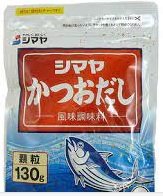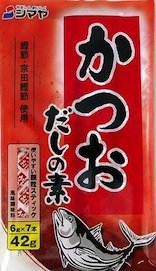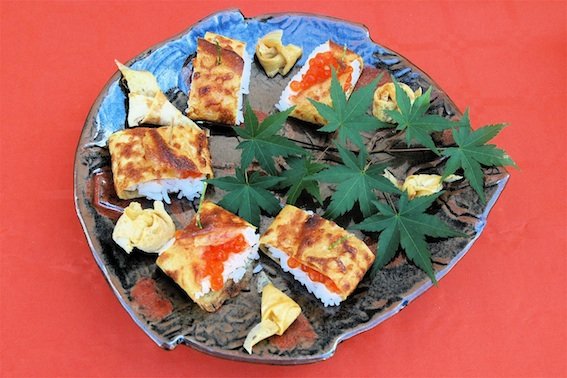Dashimaki tamago is a Japanese rolled omelette.
Both sweet and salty, it is often cooked to be put in a "bento" (lunch box) for school or travel.
It's typical Japanese home cooking I'm preparing home which remembers my family's childhood flavors.
Now, my elder son knows how to cook it better than I do !
It's often served with a meal of sushi and maki.
However a simple and casual dish, Dashimaki tamago looks quite difficult to make.
The carefull rolling of thin layers of omelette requires some little skill. Slicing it is quite easy but you will need a perfectly thin knife.
In Japanese, tamago is an egg, maki means roll and dashi is a Japanese soup stock tasting fish.
The most important is the dashi you add. If there is a higher amount of dashi and sugar, the Dashimaki will be really tasty.
Dashi can be home made with dry bonito fish.
More commonly, people find it in Japanese or Corean food stores, usually in powder (Dashi = だし).


Think about cooking pancakes with a ladle, a spatula and a pan…
If you find a square pan, specific for Tamagoyaki or Dashimaki, you're the lucky one.
Otherwise, you can grill it in an ordinary round non-stick pan of about 25cm large.
You will need half a glass of oil, only in the pan (not in the mixture).
Let's make the basic recipe, for 2 persons, which is easier to roll.
- First you will prepare the dashi, (Not all dashi powders have the same taste or concentration.)
2 teaspoons of dashi powder diluted in 1 or 2 spoons of water,
in which you can add half teaspoon of soy sauce and half teaspoon of cane sugar (following your own taste).
A bit of sugar is essential however to stick the layers together.
- You will need 4 eggs,
(1 teaspoon of dashi liquid per egg),
When you mix the eggs and dashi together, beware of not adding to much dashi at the beginning.
When you'll be more self confident making the omelette layers, you'll add more liquid progressively.
Shall we start ?
Coat you pan with enough oil, otherwise the omelette will stick.
Heat it well. (You can test with a little drop, it must sizzle.)
With a ladle, pick the quantity as if you were cooking a pancake.
Wait until the layer is still half liquid in surface : you must roll it up with the spatula before it's completely cooked.
It doesn't matter if the first roll is not perfect. You keep it inside the pan but push it at the side.
Oil the pan again. Then, you add the same quantity of mixture you needed for the first layer.
You wait till half cooked. And start rolling the first roll of Dashimaki inside the second one.
The two layers should stick partly together.
Again, keep the roll into the pan on one side.
You will add layers until the roll is more or less 4 cm thick. Don't forget oiling the pan before each layer.
If there is some mixture of eggs and dashi left, better cook a second Dashimaki .
If you want it moister, you can add a little more dashi in the omelette mixture.
Often, people will shape Dashimaki with a sushi mat.
You can wrap the rolled egg up in the mat and let it cool.
Then, unwrap the map and you’ll get nice lines on the surface of egg.
Slice the Dashimaki either thick or thin.
Be creative : you can shape hearts or leaves… Japanese style !
Here is a picture of our homemade Dashimaki tamago.

Both sweet and salty, it is often cooked to be put in a "bento" (lunch box) for school or travel.
It's typical Japanese home cooking I'm preparing home which remembers my family's childhood flavors.
Now, my elder son knows how to cook it better than I do !
It's often served with a meal of sushi and maki.
However a simple and casual dish, Dashimaki tamago looks quite difficult to make.
The carefull rolling of thin layers of omelette requires some little skill. Slicing it is quite easy but you will need a perfectly thin knife.
In Japanese, tamago is an egg, maki means roll and dashi is a Japanese soup stock tasting fish.
The most important is the dashi you add. If there is a higher amount of dashi and sugar, the Dashimaki will be really tasty.
Dashi can be home made with dry bonito fish.
More commonly, people find it in Japanese or Corean food stores, usually in powder (Dashi = だし).


Think about cooking pancakes with a ladle, a spatula and a pan…
If you find a square pan, specific for Tamagoyaki or Dashimaki, you're the lucky one.
Otherwise, you can grill it in an ordinary round non-stick pan of about 25cm large.
You will need half a glass of oil, only in the pan (not in the mixture).
Let's make the basic recipe, for 2 persons, which is easier to roll.
- First you will prepare the dashi, (Not all dashi powders have the same taste or concentration.)
2 teaspoons of dashi powder diluted in 1 or 2 spoons of water,
in which you can add half teaspoon of soy sauce and half teaspoon of cane sugar (following your own taste).
A bit of sugar is essential however to stick the layers together.
- You will need 4 eggs,
(1 teaspoon of dashi liquid per egg),
When you mix the eggs and dashi together, beware of not adding to much dashi at the beginning.
When you'll be more self confident making the omelette layers, you'll add more liquid progressively.
Shall we start ?
Coat you pan with enough oil, otherwise the omelette will stick.
Heat it well. (You can test with a little drop, it must sizzle.)
With a ladle, pick the quantity as if you were cooking a pancake.
Wait until the layer is still half liquid in surface : you must roll it up with the spatula before it's completely cooked.
It doesn't matter if the first roll is not perfect. You keep it inside the pan but push it at the side.
Oil the pan again. Then, you add the same quantity of mixture you needed for the first layer.
You wait till half cooked. And start rolling the first roll of Dashimaki inside the second one.
The two layers should stick partly together.
Again, keep the roll into the pan on one side.
You will add layers until the roll is more or less 4 cm thick. Don't forget oiling the pan before each layer.
If there is some mixture of eggs and dashi left, better cook a second Dashimaki .
If you want it moister, you can add a little more dashi in the omelette mixture.
Often, people will shape Dashimaki with a sushi mat.
You can wrap the rolled egg up in the mat and let it cool.
Then, unwrap the map and you’ll get nice lines on the surface of egg.
Slice the Dashimaki either thick or thin.
Be creative : you can shape hearts or leaves… Japanese style !
Here is a picture of our homemade Dashimaki tamago.

